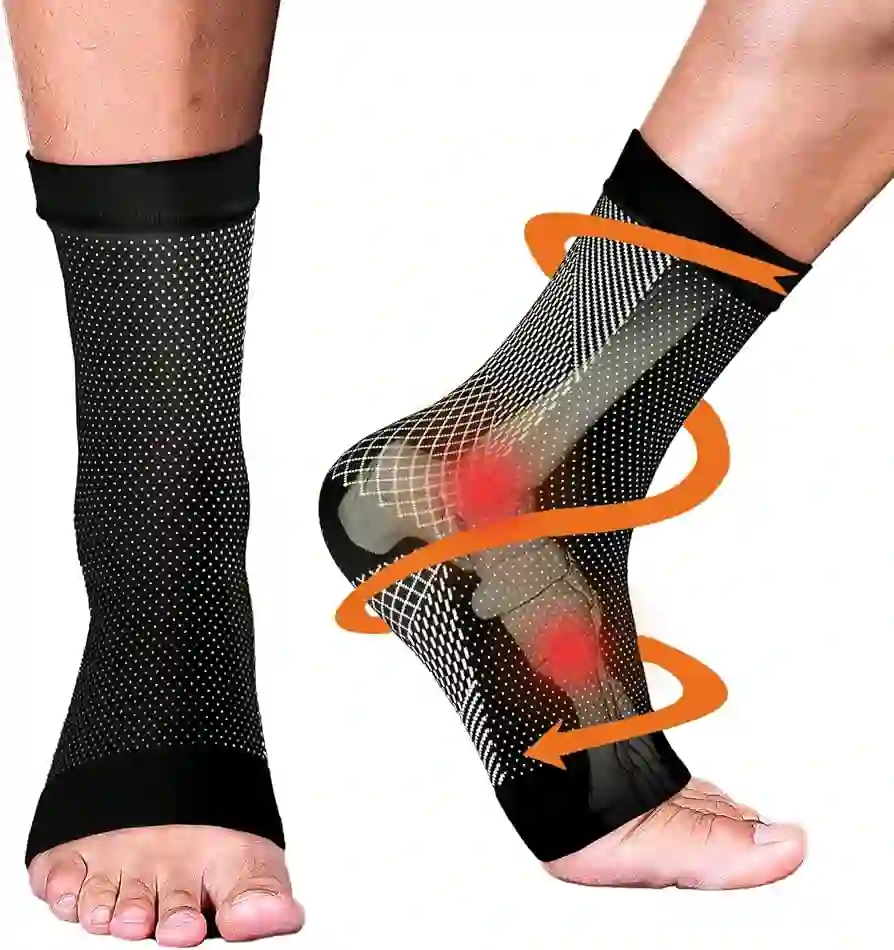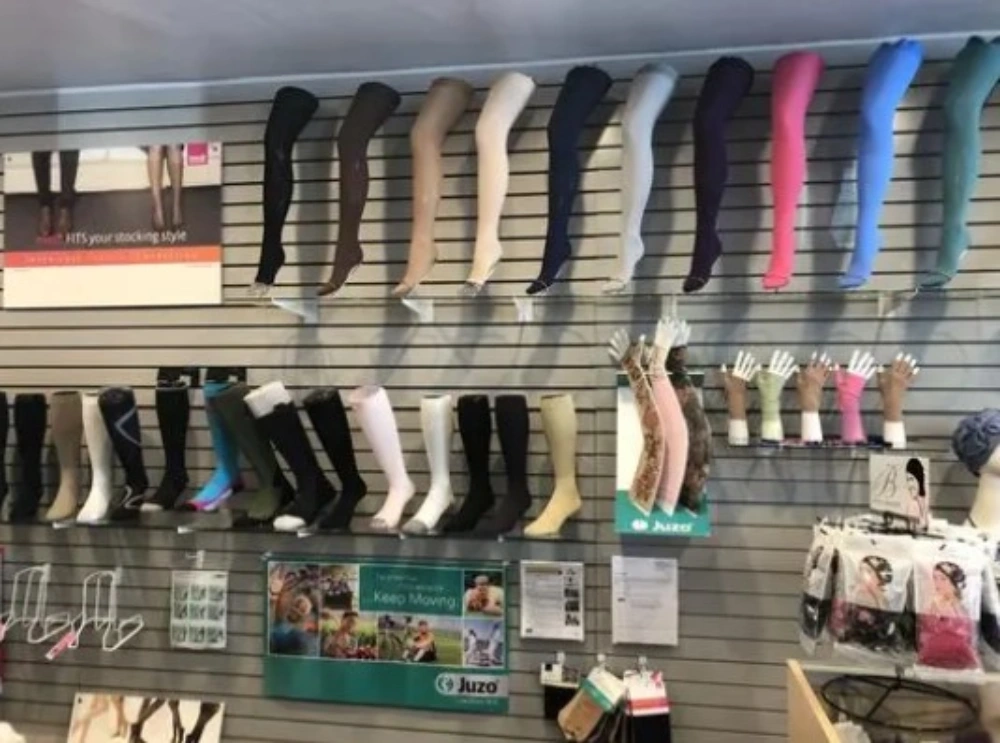Why Compression Socks Are a Game-Changer for Foot Pain Relie
Foot pain is a widespread issue affecting individuals of all ages, and it can significantly impact a person’s quality of life. From conditions like plantar fasciitis, swelling, to poor circulation, many people struggle with discomfort daily. As awareness grows, compression socks have emerged as an essential solution for alleviating foot pain while offering additional health benefits. For retailers, offering this product is a chance to meet increasing demand and provide effective relief for customers. Whether you cater to athletes, frequent flyers, or office workers, these socks address a growing concern in the wellness industry. By stocking compression socks, product managers and buyers can tap into a lucrative market and meet a real need with a practical solution.

Understanding Compression Socks: What Sets Them Apart?
Compression socks are specifically engineered to apply gradual pressure to the feet and legs, which promotes better circulation and minimizes discomfort. The gradient compression design, where pressure is highest at the ankle and decreases as it moves up the leg, encourages blood flow back toward the heart, reducing swelling and fatigue. These socks are made from materials like nylon, spandex, and elastic fibers, ensuring durability and flexibility.
The design of compression socks focuses not just on comfort but also on performance. High-quality options wick away moisture and offer breathability, allowing for all-day wear. For retailers and wellness brands, offering products that balance compression, comfort, and durability ensures customer satisfaction and long-term use.
These socks are highly effective in alleviating foot pain by targeting swelling and improving blood flow. They are particularly useful for those who spend long hours standing or sitting, such as athletes, travelers, and office workers.
Key Benefits of Compression Socks for Foot Pain
The benefits of compression socks are numerous, making them an ideal choice for those dealing with foot pain. They help in several key ways:
- Reducing Swelling and Inflammation: Prolonged periods of standing or sitting can cause feet to swell, leading to discomfort. Compression socks gently apply pressure, encouraging fluid movement and reducing swelling in the feet and ankles.
- Enhancing Blood Flow: Poor circulation is a common issue, especially for those who sit or stand for long periods. Compression socks improve circulation by applying targeted pressure, reducing the risk of conditions like deep vein thrombosis (DVT).
- Support for Chronic Conditions: Compression socks offer relief for people with chronic conditions such as plantar fasciitis and varicose veins. The socks relieve pressure on the arch and help improve circulation, easing the pain and discomfort associated with these conditions.
For retailers and brands in the health and wellness sectors, stocking compression socks tailored to address these issues can help meet customer needs and foster loyalty in a growing market.
What Retailers Need to Know About Compression Levels and Sizing
To effectively sell compression socks, understanding the different compression levels and sizing is essential.
Understanding the Different Compression Levels: Mild, Moderate, and Firm
Compression socks come in varying pressure levels, each suited to specific needs:
- Mild Compression (8-15 mmHg): Ideal for general comfort and minor swelling. Suitable for frequent travelers or individuals who need light support after a long day on their feet.
- Moderate Compression (15-20 mmHg): Recommended for plantar fasciitis, ankle swelling, and general fatigue. This level is commonly chosen by athletes and office workers who spend long hours on their feet.
- Firm Compression (20-30 mmHg): Designed for more severe conditions like varicose veins and DVT prevention. This level offers maximum circulation support and is crucial for customers with medical conditions requiring stronger compression.

The Importance of Proper Fit and Sizing for Maximum Effectiveness
Choosing the correct fit is as crucial as selecting the right compression level. Compression socks should fit snugly without causing discomfort. Retailers should offer sizing guides and ensure customers measure their ankle and calf to choose the right fit. Proper fit ensures that the socks work effectively without restricting movement or causing discomfort.
How to Guide Customers in Choosing the Right Compression Level Based on Their Needs
Retailers should offer tailored recommendations based on a customer’s lifestyle and health condition:
- Frequent travelers or office workers may benefit from mild or moderate compression to reduce swelling and fatigue.
- Athletes or individuals with plantar fasciitis may require moderate compression for additional support during activity.
- Customers with more serious conditions, like varicose veins or DVT risks, will need firm compression socks for maximum support.
Educating your customers on the different levels of compression will allow them to make informed decisions and ensure that they purchase the best product for their needs.
Materials Matter: Choosing the Right Fabric for Comfort and Durability
The materials used in compression socks are crucial to both comfort and durability. Retailers must focus on selecting socks made with high-performance fabrics that offer both compression and comfort.
Common Materials Used in Compression Socks: Nylon, Spandex, Cotton, and Wool Blends
- Nylon: Known for its elasticity and strength, nylon ensures that compression socks maintain their form and compression level over time. It also enhances durability, allowing the socks to withstand daily wear and frequent washes.
- Spandex: Provides stretchability, ensuring that the socks fit snugly while maintaining their compression. Spandex also supports the sock’s ability to provide long-lasting compression.
- Cotton: Soft and breathable, cotton enhances comfort but may not wick moisture as effectively as other materials. It’s often used in socks for casual wear or shorter periods.
- Wool Blends: Ideal for cooler climates, wool helps regulate temperature and is moisture-wicking. It’s great for customers who want comfort and warmth alongside compression.

The Benefits of Moisture-Wicking and Breathable Fabrics for Comfort
Moisture-wicking fabrics, such as nylon and spandex, are key to ensuring that feet remain dry and comfortable. These materials draw moisture away from the skin, preventing the buildup of sweat and bacteria, which is particularly important for customers who wear compression socks for extended periods.
Why Durability is Key for Repeated Wear and Long-Term Relief
For retailers, offering durable compression socks is essential. These socks should withstand repeated use and washing without losing their compression or shape. Nylon and spandex blends provide the necessary durability, ensuring that customers get lasting relief from foot pain and comfortable wear over time.
Features That Enhance Comfort and Effectiveness
Cushioned Soles, Arch Support, and Seamless Toe Construction
- Cushioned Soles: Provide extra comfort, especially for customers who spend long hours on their feet. This feature reduces foot fatigue and alleviates pressure on sensitive areas like the heel and arch.
- Arch Support: Crucial for individuals with foot pain or conditions like plantar fasciitis. Compression socks with arch support help distribute pressure evenly across the foot and reduce strain.
- Seamless Toe Construction: Ideal for those with sensitive skin or conditions like bunion. Seamless toes reduce friction, which helps prevent blisters and irritation.
How Added Features Contribute to Overall Comfort and Pain Relief
These added features significantly enhance the effectiveness of compression socks by reducing discomfort and supporting pain relief. Customers appreciate socks that not only offer therapeutic compression but also cater to their specific comfort needs.
The Importance of Materials That Are Soft on the Skin While Providing Compression
Soft, comfortable materials that feel good on the skin are essential for ensuring that customers wear their compression socks regularly. Bamboo, cotton, and nylon blends are ideal for providing a smooth feel against the skin, improving comfort without compromising on compression effectiveness.
How Compression Socks Can Fit Into Your Store’s Product Line
Integrating compression socks into your product line is a great way to cater to a growing demand for foot pain solutions. They fit seamlessly into wellness, athletic wear, and travel accessories categories, making them versatile for a wide range of customers.

Positioning Compression Socks as a Wellness and Health Solution
Market these socks as therapeutic tools that not only offer comfort but also help with circulation improvement, swelling reduction, and chronic foot pain relief. For health-focused retailers, positioning these socks as part of your wellness product line will appeal to customers looking to improve their overall health and comfort.
Adding Compression Socks to Categories Like Athletic Wear, Health Products, or Travel Accessories
- Athletic Wear: Ideal for athletes and fitness enthusiasts who need recovery support.
- Health Products: Perfect for customers seeking solutions for chronic foot pain or swelling.
- Travel Accessories: A must-have for frequent travelers who need circulation support on long flights.
Marketing Compression Socks for Foot Pain as a Must-Have for Various Demographics
Target different demographics such as athletes, frequent flyers, and office workers who can benefit from compression socks tailored to their specific needs.
Educating Customers: How to Sell Compression Socks for Foot Pain
Educating customers on the health benefits and proper usage of compression socks is key to making informed sales.
Teaching Customers About the Benefits and Proper Use of Compression Socks
- Health Benefits: Explain how compression socks improve circulation, reduce swelling, and alleviate foot pain.
- Proper Use: Instruct customers on the best times and methods for wearing compression socks, ensuring they see the value of consistent use.
How to Make Recommendations Based on Lifestyle and Foot Pain Needs
Tailor your recommendations based on lifestyle and specific needs, whether it’s for frequent travel, standing jobs, or sports recovery.
Training Your Sales Team to Provide Informed Advice on Foot Pain Relief Options
Equip your team with knowledge about compression therapy, compression levels, and materials, so they can confidently help customers select the best pair of socks for their needs.
Trends in the Compression Socks Market: What Retailers Should Watch
The compression socks market is evolving, with innovations and shifting consumer preferences. Retailers must stay ahead of the curve to meet growing demand.
Rising Consumer Interest in Wellness and Self-Care Products
As consumers become more health-conscious, they are increasingly turning to compression socks as part of their self-care routine.
Innovations in Compression Sock Design: Eco-Friendly Materials, Stylish Options, and Advanced Technology
Look out for eco-friendly materials, stylish designs, and innovative technology in compression socks that cater to the evolving demands of consumers.
How to Stay Ahead of the Curve by Offering Trendy, High-Quality Products
Offer a diverse selection of high-quality, innovative products that combine health benefits with fashion-forward designs to attract a broader customer base.
Why Compression Socks Are a Smart Investment for Retailers
With increasing demand for foot pain relief solutions, compression socks are a smart investment for retailers.
Recap of Key Selling Points: Health Benefits, Comfort, and Customization Options
Compression socks provide health benefits, comfort, and customization options that meet a variety of customer needs, making them a versatile and in-demand product.
A Final Call-to-Action for Retailers
Retailers should seize the opportunity to add compression socks to their product lines, tapping into a growing market of customers seeking effective foot pain relief and wellness solutions.
FAQ About Compression Socks
- What are the key benefits of offering compression socks for foot pain to my customers?
Compression socks reduce swelling, improve circulation, and relieve foot pain, making them ideal for people with active lifestyles or those who stand or sit for long periods. - How do I choose the right compression level for different customer needs?
Compression levels range from mild (for comfort) to firm (for medical conditions like varicose veins). Moderate compression is ideal for foot pain relief and active individuals. - Can I customize compression socks for my brand?
Yes, you can customize size, color, design, and logos to match your brand identity and target customer preferences. - What materials should I look for when selecting compression socks for my store?
Look for durable materials like nylon, spandex, and cotton blends that offer comfort and effective compression. Eco-friendly options are increasingly popular among consumers. - What is the market demand for compression socks in my region?
The demand is growing, especially in the U.S., Europe, and Australia, where consumers are seeking wellness solutions for foot pain relief.
